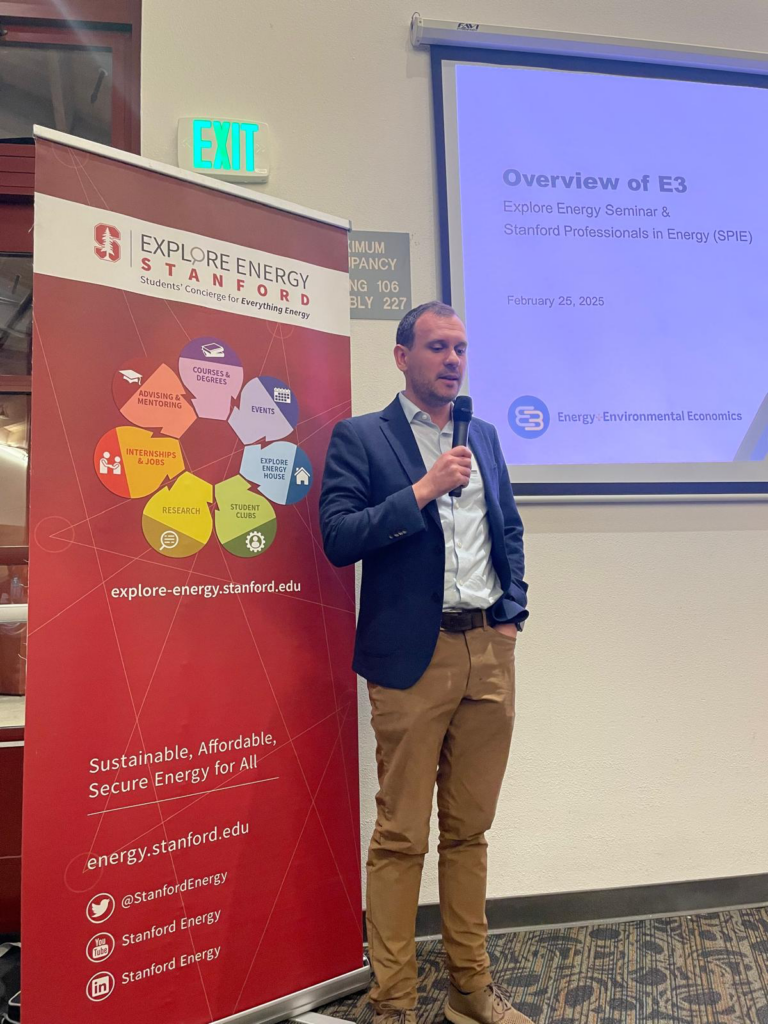
This winter, Zach Ming, Partner at E3 and adjunct lecturer at Stanford, wrapped up his seventh year teaching Stanford’s graduate course, Electricity Economics, a class that’s quickly become a foundational piece of the university’s energy curriculum.
Offered through Stanford’s Civil and Environmental Engineering department, the course draws a diverse group of graduate students — primarily master’s and PhDs, along with a handful of law, business, and undergraduate students — who are looking to understand how the electricity system actually works, from regulation to planning to operation. While the class is built on a solid foundation of economic principles, its goal is practical: to help future leaders understand how real-world electricity systems function, and how economic concepts apply in today’s policy and planning landscape.
Topics span the core building blocks of utility regulation (natural monopolies, rate design, revenue requirements) as well as system planning and operations, including least-cost dispatch, reliability, electricity markets, and how to think about least-cost portfolios in a high-renewables grid. Zach emphasizes system-level thinking: not which individual resource is cheapest, but how to build the lowest-cost system overall.

It’s the kind of material that often gets overlooked in traditional energy curricula. As Zach describes it, the course is meant to fill the gap between academic theory and the practical dynamics of regulated electricity systems. “We’re not training reliability experts in 10 weeks,” he says, “but students leave the course understanding why the system is structured the way it is, and how different resources and decisions affect it.”
Zach’s connection to Stanford goes beyond the classroom. He was once a student in a similar Stanford course taught by E3’s founder, Ren Orans. E3 is proud to sponsor this class for Stanford, as supporting education has long been a core part of the firm’s mission. At least eight former students have gone on to join E3, and many more have brought what they’ve learned into roles at utilities, regulatory agencies, and energy organizations across the country.
For the last class each year, Zach invites an industry leader to speak with students about how the concepts covered in the course play out in real-world decision-making. This year’s guest was Elliot Mainzer, President and CEO of the California ISO, who spoke about grid operations, reliability, and the practical application of economic planning principles in one of the country’s most complex energy markets. Previous guest speakers have included former FERC Commissioners Neil Chatterjee and Pat Wood, former Texas PUC Chair Peter Lake, and others from across the regulatory and utility landscape.
In many ways, Zach’s classroom is an extension of what he helped build at E3. He also designed the firm’s internal New Hire Training, an intensive, 6–8 week program that covers the fundamentals of public utility regulation, energy finance, cost-effectiveness tests, wholesale markets, and integrated planning. All new E3ers go through the training, which builds a shared understanding of how the electric sector fits together and reflects the range of E3’s work.
Today, Electricity Economics is an established part of Stanford’s energy curriculum, fulfilling degree requirements and drawing more than 50 students each year. It helps bridge the gap between academic training and the kinds of decisions graduates will face in roles at utilities, public agencies, and energy companies on reliability, cost, planning, and policy that are only getting more complex as the grid evolves.


